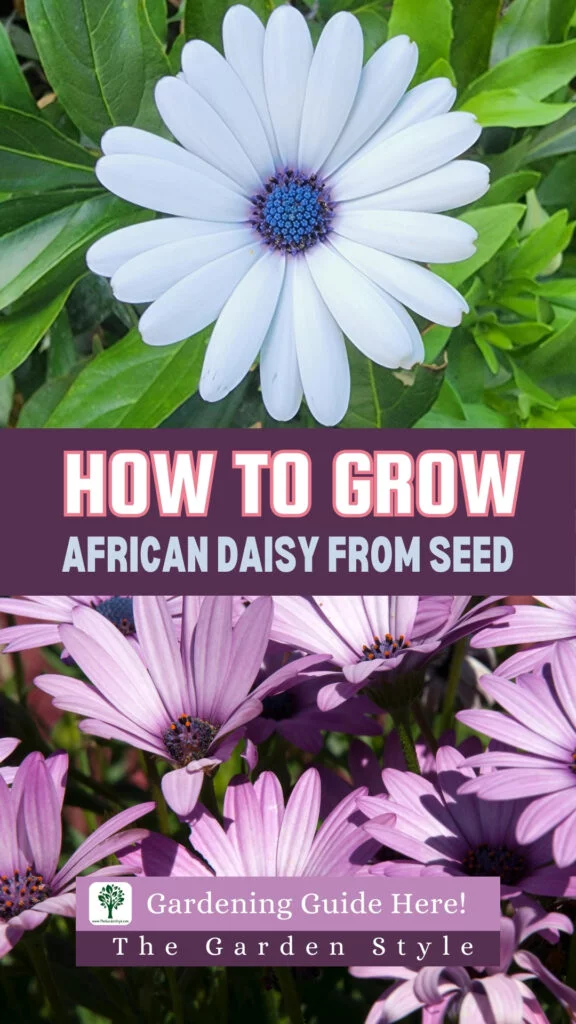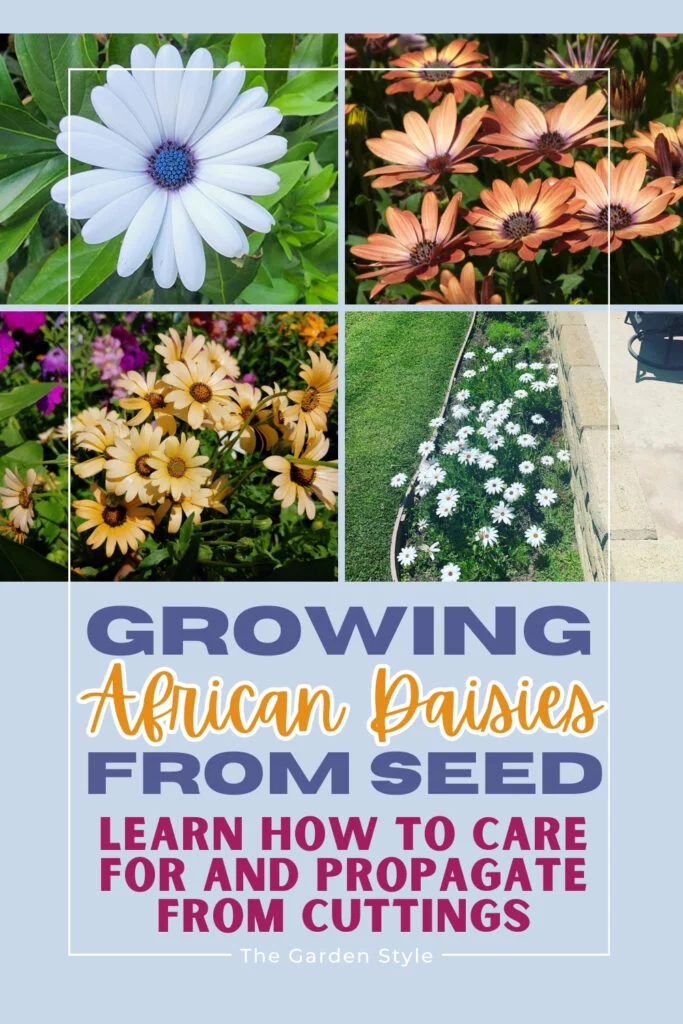African daisies, also known as Cape daisies, are cheerful, sun-loving flowers that brighten up any garden with their vibrantly colored, daisy-like blooms. While you can purchase established plants, there’s something immensely satisfying about growing these beauties yourself from seed. With a little time, care, and the right conditions, you can cultivate a flourishing patch of African daisies to enjoy their eye-catching flowers all season long. In this guide, we’ll explore how to grow African daisies from seed for stunning blooms that will light up your outdoor spaces!
Table of Contents
What are African Daisies?
African daisies (Osteospermum), also known as Cape daisies, are a genus of flowering plants native to Africa and the Mediterranean region, which is how they got their common name. They produce large, showy, daisy-like flowers in a range of vibrant shades like purple, white, yellow, orange, and pink.
The enormous blooms can reach up to 5 inches wide, featuring contrasting colored rings around yellow or purple centers. The petals may be solid hues or bicolored. Depending on the variety, African daisy plants range from compact 6-inch mounds to larger 3-foot mounds.
In warm, frost-free climates like USDA zones 9-11, African daisies can be grown as perennials that return year after year. In cooler regions, they are typically treated as annuals since they can’t survive freezing winter temperatures. But even when grown as annuals, they provide months of continuously blooming color.
African daisies are an excellent choice for bouquets and cut flowers. They typically have long stems and vibrant, daisy-like flowers that can add a pop of color and texture to floral arrangements. Additionally, they have a relatively long vase life if properly cared for, making them suitable for use in bouquets and cut flower displays.
| Characteristic | Description |
| Botanical Name | Osteospermum |
| Common Names | African Daisy, Cape Daisy, Blue-Eyed Daisy |
| Plant Type | Herbaceous flowering annual or perennial |
| Size | 6 inches to 3 feet tall |
| Flowers | Daisy-like, up to 5 inches wide, shades of purple, white, yellow, orange, pink |
| Bloom Time | Spring through Fall |
| Light | Full sun |
| Water Needs | Drought tolerant once established, but better bloom with consistent moisture |
| Soil | Well-drained |
| Hardiness | Perennial in zones 9-11, grown as annuals in cooler areas |
| Origins | Native to Africa and Mediterranean region |
| Uses | Beds, borders, containers, ground cover |
Recommended reading: How to Start a Cut Flower Garden: Plan and Layout
Types of African Daisy
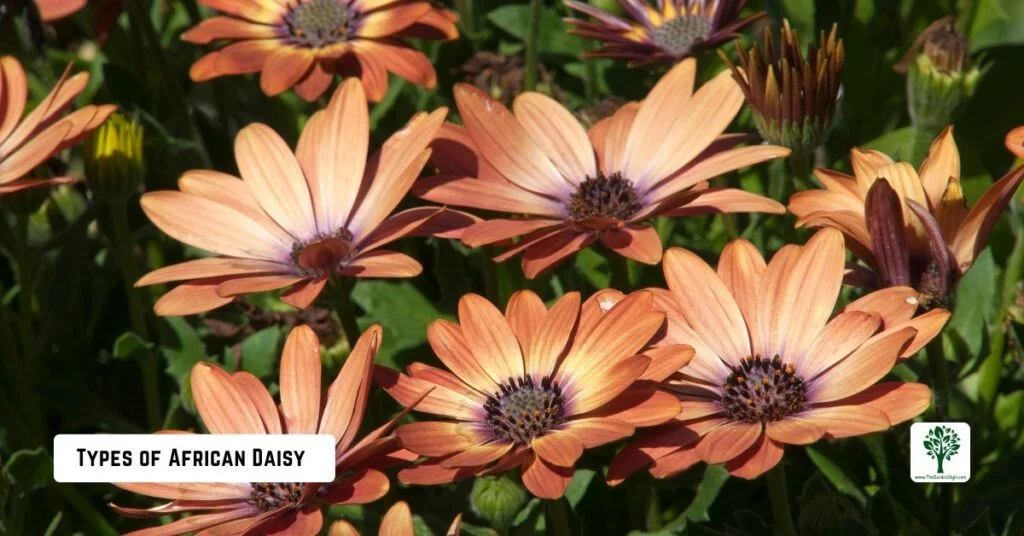
African daisies come in a variety of cultivars, each with its unique characteristics and color variations. Some popular types include:
- Osteospermum ecklonis: Also known as the Cape daisy, Osteospermum ecklonis is one of the most common varieties of African daisies. It features large, daisy-like flowers in shades of purple, pink, white, and orange. This variety is known for its tolerance to a wide range of growing conditions, making it a favorite among gardeners.
- Osteospermum jucundum: Osteospermum jucundum, or the trailing African daisy, is a low-growing variety that is perfect for cascading over walls or spilling out of containers. It produces an abundance of small, daisy-like flowers in shades of purple, blue, and white, adding a splash of color to any garden or landscape.
- Osteospermum barberiae: The Osteospermum barberiae, commonly known as the trailing African daisy or purple-eyed daisy bush, is a vigorous, spreading plant with attractive dark green foliage and striking purple-centered flowers. This variety is well-suited for ground cover or trailing over walls and has a long flowering period, providing months of color in the garden.
- Osteospermum ‘Serenity’ Series: The ‘Serenity’ series of African daisies is renowned for its compact growth habit and large, vibrant flowers. Available in a range of colors, including shades of pink, purple, and orange, these hybrids are bred for their uniformity and long-lasting blooms, making them an excellent choice for containers or mass plantings in the garden.
Starting African Daisies from Seed
While the stunning hybrid varieties of African daisies you often see at the nursery are typically only available as established plants, it is possible to grow some pure species forms from seed. One option is Osteospermum ecklonis, also known as the blue-eyed African daisy. With a bit of patience, you can cultivate these cheerful daisy-like blooms right from seed.
- Dramatic Bloom – Osteospermum is a gorgeous African daisy with white petals, deep purple eyes, and a lovely scent. The plants, grown from our daisy flower seeds, reach 12-18 inches tall, and can be enjoyed in the outdoor garden or cut for indoor flower arrangements.
- Perennial Flower – A low-maintenance flower that comes back year after year in zones 8 and above, making our African daisy seeds a gardening favorite. Bees and butterflies also are attracted to the sweetly fragrant blossoms of the African cape daisies.
How to Grow African Daisies from Seed
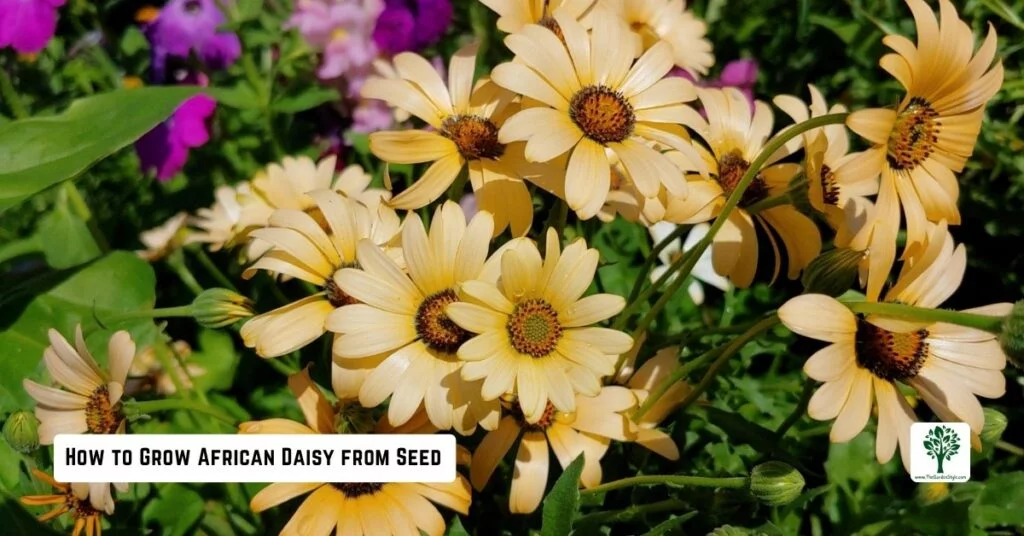
African daisy seeds can be started indoors 6-8 weeks before your last expected spring frost date. This gives the seedlings plenty of time to grow big and strong before going outside. Learn more about how to start seeds indoors.
For an earlier bloom period, you can start them even earlier indoors under grow lights. Just be sure to slowly acclimate them to outdoor conditions before transplanting.
Select the right seeds. Opt for high-quality seeds from a reputable supplier to ensure the best chances of success. Look for seeds that are fresh, plump, and free from any signs of damage or mold. That ensures that you’re starting with the healthiest foundation for your daisy-growing endeavor.
Once you’ve acquired your seeds, it’s time to sow them and kickstart the growth process. Prepare a seed tray or small pots filled with a well-draining potting mix. Ensure that the soil is loose and friable to facilitate healthy root development. Lightly press the seeds into the soil and cover them with a thin layer of compost. That helps to provide nutrients and insulation for the seeds as they germinate.
It’s crucial to maintain consistent moisture in the soil, but avoid waterlogging, as excess moisture can lead to rotting of the seeds. Place the seed tray or pots in a warm, sunny location to provide the optimal conditions for germination.
Patience is key during the germination process of African daisy seeds. Under ideal conditions, these seeds typically sprout within 7 to 21 days. However, factors such as temperature variations and growing conditions can influence the germination timeline. Keep a close eye on the soil moisture levels and ensure that the seeds receive adequate sunlight for optimal growth.
Once the seedlings emerge, it’s important to thin them out to prevent overcrowding and allow each plant ample space to thrive. This step promotes better airflow and reduces competition for nutrients, ultimately leading to healthier, more robust plants.
Caring for African Daisy Seedlings
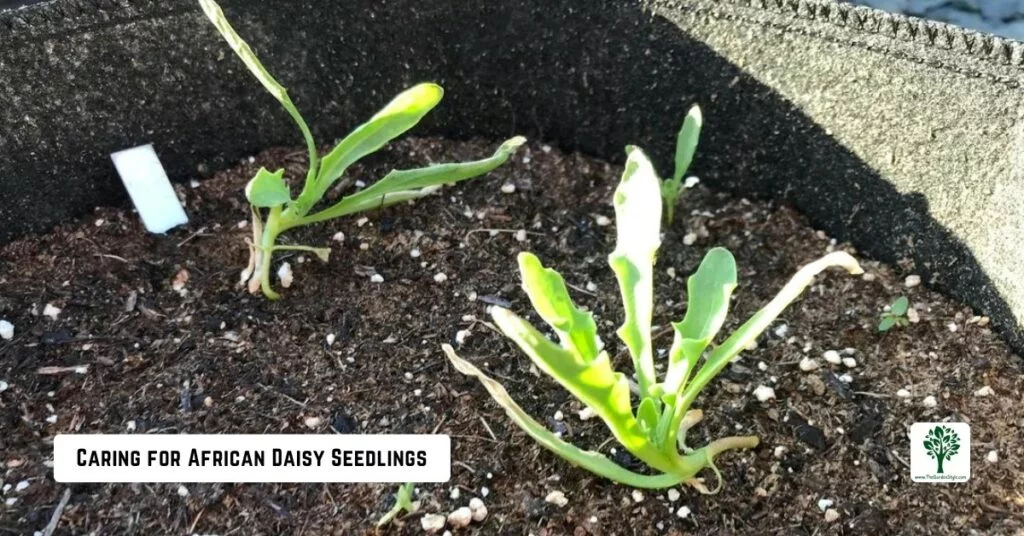
Once your African daisy seeds have germinated, providing proper care for the delicate seedlings is crucial. These young plants have specific needs for light, water, and nutrients during their initial growth stage. With the right conditions, you can nurture the seedlings into sturdy, healthy transplants ready to thrive outdoors. Follow these tips for successfully caring for your African daisy seedlings:
Water and Light Requirements
Once seedlings emerge, place them in a sunny window or under grow lights. African daisy seedlings need 6-8 hours of direct light per day.
Water them whenever the top inch of soil begins to dry out, taking care not to oversaturate the delicate roots.
Fertilizing
Fertilize the seedlings every two weeks with a balanced liquid fertilizer diluted to half strength. This provides the nutrients they need for strong, compact growth.
Hardening Off
After all danger of frost has passed, it’s time to get those seedlings ready for life outdoors. The process of hardening off gradually introduces them to sunlight, wind, and fluctuating temperatures.
Over 7-10 days, slowly increase their outdoor exposure by a few hours each day. Bring them in at night. By the end of the hardening period, they’ll be tough enough to handle the great outdoors.
Transplanting and Continued Care
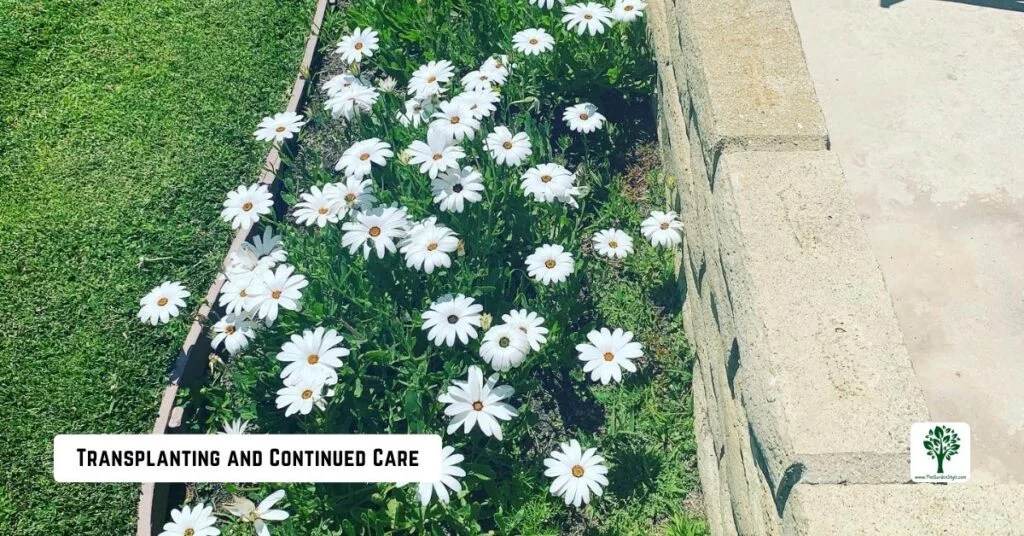
With their indoor growing phase complete, it’s time to transition your African daisy seedlings to the great outdoors. Proper transplanting and continued care will help these young plants thrive in the garden. Follow these tips for successfully establishing your African daisies in their new home.
Choosing a Planting Site
African daisies thrive in full sun. Find a spot in your garden that gets 6-8 hours of direct sunlight per day. They’ll tolerate partial shade but with fewer blooms.
These heat and drought-tolerant plants do best with well-drained soil. Amend heavy soils with compost to improve aeration and drainage.
Soil Preparation
Prepare the planting area by digging in 2-4 inches of compost and mixing it into the top 6-8 inches of soil. This enriches the soil and helps create the well-drained conditions African daisies love.
Spacing and Planting
Space African daisy transplants 12-18 inches apart in the prepared bed. Dig holes slightly wider than the root balls and plant them at the same depth they were growing in their containers.
Gently firm the soil around the rootballs and water well. Applying a 2-3 inch layer of mulch will help conserve moisture and suppress weeds. Learn more about different types of mulches.
Ongoing Water and Fertilizer Needs
While established African daisies can handle dry conditions, they bloom their best with consistent moisture. Aim to provide about 1 inch of water per week through rainfall or irrigation.
Feed plants monthly during the growing season with a balanced liquid fertilizer to promote lush growth and prolific blooms.
Propagate African Daisies from Cuttings
After successfully establishing your African daisy plants, you might want to accelerate the growth process by propagating them from cuttings instead of relying solely on seeds.
In the following video you can learn how to propagate African daisies from cuttings:
Buying Established Plants
No seed, no problem! You can find African daisy plants for sale at many nurseries and garden centers in spring and early summer.
What to Look For?
When purchasing African daisy plants, look for compact plants with healthy foliage and tight, unopened buds just starting to show color. Steer clear of leggy, overgrown plants with lots of open flowers, as they’ll be past their prime soon.
Transplanting Potted Plants
To transplant potted African daisies, dig a hole twice as wide as the nursery container. The hole should be just as deep, placing the top of the rootball even with the soil surface.
Gently rough up the outer roots and position the plant in the hole. Backfill with soil amended with compost or planting mix, gently firming as you go. Water thoroughly.
Care for Established Plants
The primary needs for established African daisies are:
- Full sun exposure
- Well-drained soil
- Consistent moisture
- Deadheading spent blooms to encourage rebloom
- Light grooming to remove dead or damaged foliage
With the proper care, African daisy plants will bloom abundantly for several months in spring through fall before going semi-dormant in winter. Learn more about how to take care of African daisies.
African Daisies Common Pests and Diseases
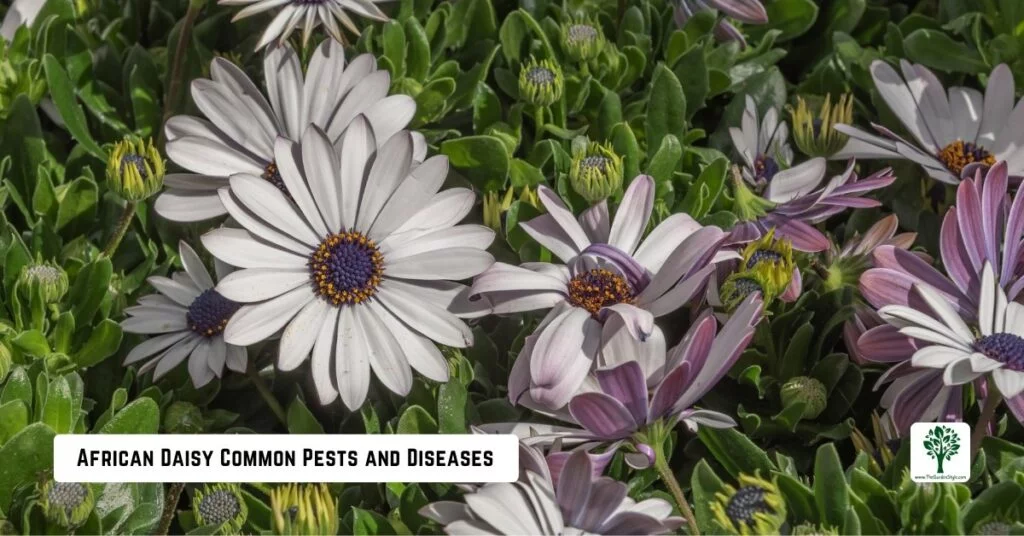
While African daisies have good overall resistance to pests and diseases when grown in proper conditions, there are still some common issues to watch out for:
Pests
- Aphids: These small sap-sucking insects can spread viruses and cause leaves to curl and distort. Dislodge with strong water spray or use insecticidal soap.
- Spider Mites: Hot, dry conditions allow these tiny spider-like creatures to spread, causing yellowed, stippled leaves. Spray plants with water or use insecticidal soap or horticultural oil.
- Thrips: Evidenced by silver-white streaking or distortion on leaves and flowers, thrips can spread viruses. Use an insecticidal soap spray.
Diseases
- Powdery Mildew: This fungal disease appears as a white, powdery coating on leaves. Improve air circulation and avoid overcrowding plants.
- Root/Stem Rots: Caused by overly wet, poorly draining soil. Amend soil with compost and ensure good drainage.
Providing African daisies with the right growing conditions and spacing is the best defense against most pest and disease problems. Inspect plants regularly and take appropriate action at the first signs of issues.
Companion Plants for African Daisies
| Companion Plant | Benefits |
| Lavender | Similar care requirements, color, and fragrance complement |
| Salvia | Attracts pollinators, similar care needs |
| Marigolds | Repels pests, adds vibrant color |
| Alyssum | Ground cover, attracts beneficial insects |
| Coreopsis | Attracts pollinators, complements African daisies |
| Catmint | Repels pests, attracts beneficial insects, adds texture |
| Russian Sage | Adds height and texture, attracts pollinators, repels pests |
Conclusion
Whether you grow them from seed or established nursery plants, African daisies are showy, low-maintenance additions to any sunny garden. With their bright colors, long bloom season, and drought tolerance, they’re bound to quickly become favorites. Give these cheerful bloomers a try!
Frequently Asked Questions
Yes, African daisies are perennials, meaning they can come back year after year with proper care, providing you with beautiful blooms season after season.
For starting African daisy seeds indoors, aim for about 6-8 weeks before the last frost date in your area. This timing allows the seeds to establish strong roots before transplanting them outdoors in the spring.
Rest assured, African daisies are not poisonous to dogs. You can enjoy their vibrant colors in your garden without worrying about any harm to your furry friends.
When it comes to deer resistance, African daisies are generally considered to be deer-resistant plants. While no plant is completely immune to deer browsing, African daisies have properties that make them less appealing to these garden visitors, reducing the likelihood of damage to your precious blooms.
If this post about how to grow African daisies from seed was helpful, please share it:
